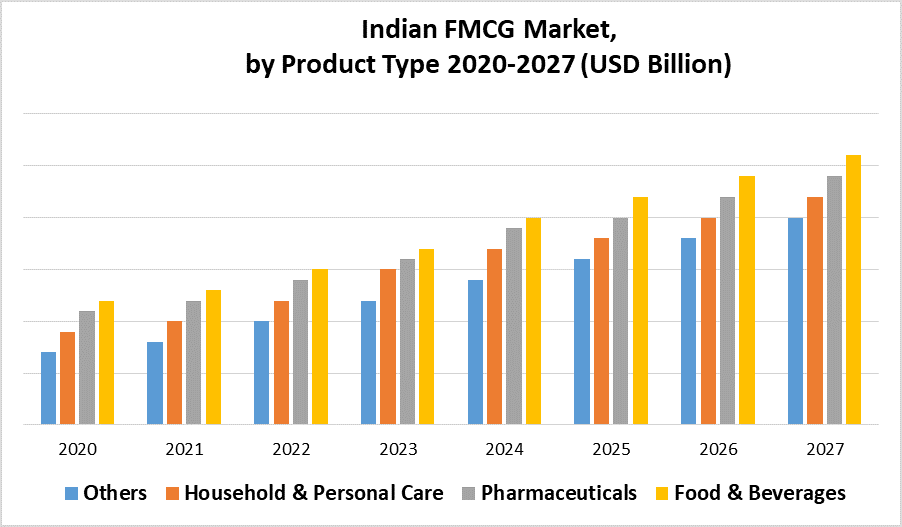People use different products on a daily basis. Starting right from a brand of toothpaste, soaps and shampoos to consuming a variety of vegetables, grains, and packaged snacks. But what is common about all these products? These goods are consumed by everyone, keeping their demand high. Moreover, they are frequently bought as they are consumed within a few days or weeks. Such products are known as FMCG or fast-moving consumer goods.
Read further to know what FMCG goods are and their types.
You will Learn About:
What are Fast-Moving Consumer Goods (FMCG)?

Fast-moving consumer goods are those goods that have a short shelf life and are consumed very quickly. This is because they are products of everyday use that customers frequently buy and come at low costs. Some of these goods are also perishable, which is why their consumption is quick. A few examples of FMCG are confectionary items, meat products, milk and dairy, etc.
FMCG goods have the following features:
- They are used frequently by customers.
- They are quickly consumed. This consumption period can range from a few weeks to even a few days.
- FMCGs come at low costs. This makes them affordable for a majority of the population.
- They have a high demand because they satisfy the basic requirements of people.
Understanding FMCG
The high demand and affordability of FMCG products make them widely available across all convenience stores.
All the fast-moving consumer goods (products like bread, chips and soda, fruits, frozen and ready-to-eat products, and even things like soaps, detergents, notebooks, and markers) can be classified under different categories. These are
- Durables
These are those FMCG products that do not perish easily. They can stay on the shelves for a long time, sometimes even a few years. Moreover, these goods can be used multiple times before they are completely exhausted. For example, shampoos and tubes of toothpaste.
- Non-durables
Non-durables are those FMCG products that have a very short shelf life. They are quickly consumed and move very fast from producers to consumers. For example, bread, vegetables, and fruits fall under this category.
Due to their nature as quick-consumption goods, the turnover rate of the products in the FMCG industry is very high. Moreover, the demand for such goods remains constantly high, mainly because such goods are essentials in everyday life.
Indian FMCG industry

The FMCG market is also huge, as it covers a wide range of products. In the last 10 yrs, the Indian FMCG industry has had a growth rate of 21.4% and is the 4th largest sector of the Indian economy. Since most products that are classified as FMCGs include edible goods and those used for personal care, the industry is primarily regulated by the Food Safety and Standards Authority of India (FSSAI).
There is also fierce competition in the large-sized FMCG industry. Big FMCG companies make constant efforts to differentiate their products from competitors. This is done through marketing and promotional techniques, including establishing a strong brand presence, active advertising, giving large discounts and offering other incentives to buyers.
There is also competitive product pricing, which is used as a strategy to attract more customers.
Some of India’s key players in the FMCG industry are Hindustan Unilever, ITC, Godrej Consumer Products, Nestle India, and Tata Consumer Products. Each of these companies, despite being large conglomerates, constantly competes with each other to attain a larger market share and promote their products.
There are various kinds of fast-moving consumer goods. Let us see some of their major categories.
Types of FMCG goods

Some of the major kinds of products are:
- Ready-to-eat food: These are packaged foods that are available as pre-cooked meals. These can be consumed straight out of the packet.
- Fresh produce: This includes fresh fruits and vegetables. These are highly perishable.
- Frozen food: Frozen food such as frozen peas and fries come in this category.
- Beverages: Soft drinks and even packaged drinking water are some examples.
- Cleaning products: This includes products that are used for everyday cleanings, such as dish soap and toilet cleaners.
- Medicines: Medicines that can be purchased without a prescription are included here.
- Cosmetics: This includes cosmetics such as skincare and hair care products and make-up items.
Top FMCG companies in India
The following are the major FMCG companies in India:
| Company Name | Industry | Ticker | Market Capitalisation as on 11th August 2022 (In Rs.) |
| Hindustan Unilever | Household and personal care | HINDUNILVR | 6,15,123 crores |
| Britannia Industries | Food and beverages | BRITANNIA | 87,924 crores |
| Nestle India | Food and beverages | NESTLEIND | 1,89,771 crores |
| ITC | Cigarettes and other FMCG products | ITC | 3,81,322 crores |
| Godrej Consumer Products | Household and personal care | GODREJCP | 88,293 crores |
| Gillette India | Household and personal care | GILLETTE | 16,877 crores |
| Dabur India | Household and personal care | DABUR | 1,03,566 crores |
| Marico | Household and personal care | MARICO | 66,418 crores |
| Colgate Palmolive | Household and personal care | COLPAL | 42,893 crores |
| Bajaj Consumer Care | Household and personal care | BAJAJCON | 2,409 crores |
| Proctor and Gamble Hygiene and Healthcare | Hygiene and Healthcare | PGHH | 47,299 crores |
Conclusion
Fast-moving consumer goods have a high demand and are consumed quickly. Depending on their shelf life, they are divided into two categories – durables and non-durables. We use FMCGs on a daily basis, some examples of which include soap bars, cosmetics, fruits, oil, and more. The FMCG industry in India comprises some strong players, such as HUL, Nestle India, and Dabur, which have made a name for themselves by providing everyday essentials to consumers at a low cost.



